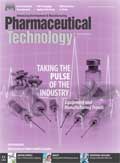News
Article
Pharmaceutical Technology
Environmental Containment Performance—Is There Accountability?
Author(s):
Engineered containment performance testing is a more robust method for validating containment systems than worker-exposure measurement methods.
Image is courtesy of Powder Systems Limited.

With the advent of potent drugs, the pharmaceutical industry needed contained work practices for operator and environmental protection; manufacturers had to implement and validate containment solutions. To accomplish these operations, the pharmaceutical industry looked at containment designs used in nuclear energy plants. In addition to using advanced containment technologies, health physicists in the nuclear industry conducted intense surveillance monitoring for workers and their equipment and used engineered performance testing. The same test method can be used for validating pharmaceutical containment solutions.
Engineered containment performance testing (ECPT)
To monitor containment performance, the nuclear community developed a statistically robust method, based on a model of repeat sampling of a data set of five samples. When the data are compliant, a statistical strength of >95% coefficient of variability (CVt) is achieved. Engineering performance of hardware is established, and testing encompasses operation of tasks by an operator based on repeatability. This methodology provided a more complete and robust method of testing a containment system, based on actual equipment performance, prior to testing the operator exposure during operation.
When the need to qualify pharmaceutical containment performance began in earnest in 1993, this design model was adopted with great success. Repeatability of the method was proven feasible. Baseline data developed during installation qualification (IQ) allowed glovebox integrity to be tracked through operational qualification (OQ), performance qualification (PQ), process performance qualification (PPQ), and maintenance throughout the working life and final disposal of the equipment. This method provided robust statistical data and was later adopted for monitoring of equipment, manufacturing suites, entire facilities, and in one case, shared warehousing and dispensing to satisfy a regulatory request.
Standardized measurement of particulate airborne concentration (SMEPAC)
In the late 1990s, occupational health professionals focused on worker exposure measurement as the primary target to qualify containment equipment through workplace outcomes, regardless of the source. The method was formalized as SMEPAC, later adopted and revised by the International Society for Pharmaceutical Engineering (ISPE). The random nature of this guidance on sampling methods and distribution does not lend to a specific measure of containment equipment or device. The data have no statistical validity. More importantly, the method does not provide a baseline dataset for future integrity testing.
Comparing sampling methodology
One has to first decide what the data are to be used for. It is legitimate to use the Good Practice Guide for Assessing Containment Performance (formally SMEPAC)/ISPE method for worker outcomes due to all sources of emissions within a single test environment. The ECPT statistical methodology targets the engineering capability of the containment device while accounting for artifacts due to all extraneous sources, regardless of the placement of the device. In both cases, it helps if the dustiness index of the source/test agent is known for comparison purposes. The two approaches differ in both major sampling design and sampling details.
The SMEPAC method and approach addresses the outcome of the operational procedure within a room enclosure. Samples are deployed in a specific manner to measure the worker, room air, and containment enclosure breach-point environments using single samples per trial run. The total number of sample locations is usually restricted to less than eight.
The ECPT statistical (artifact corrected) method uses a randomized grouping of five samples placed within the air space surrounding the containment enclosure, plus samples located at potential breach points, the worker, the test enclosure, and the air inside and outside the test environment. Sample randomization is achieved by:
- dividing the internal volume of the containment equipment into equal volumes (eight or more)
- extending these volumes outside the enclosure (eight internal spaces leads to 56 external)
- sequential numbering of the resulting spaces around the skin of the equipment
- using a random number approach to locate five sample locations within these spaces
- excluding breach point locations for this sample set.
These differences in sampling clearly show that the ECPT method will provide more relevant results. The following case study demonstrates an example of ECPT set-up and results.
Case study: ECPT methodology
In this case study, the ECPT methodology was used. Engineered containment performance was completed on a filter dryer with a heel removal glovebox. The glovebox (see Figure 1) is used for taking samples during the process and off-loading of the final compound.
Figure 1: 0.125 m2 filter dryer and glovebox.

The filter dryer and the glovebox were tested as separate entities, not just in the room environment such as in the SMEPAC method. The strategy was to conduct three unit-operation studies in a controlled and unventilated space, which is the worst-case scenario. This plan targeted sample locations inside the spatial array for a total of three hours. Performance of operator tasks was done during the equipment operation, including statistically random sampling around the equipment.
The scope of work included measurement of the operational fugitive releases using milled lactose as the placebo compound, environmental impact during the operation of the equipment, and the operator exposure potential. The testing included background samples prior to equipment operation, during operation of the equipment, and after cleaning. Cleaning is an important part of the testing, which is not considered in some testing protocols.
To test the equipment, an environment enclosure was erected around the equipment. A sampling manifold was constructed around the equipment to locate the samples at key selected sample points. The equipment was placed in a non-ventilated testing enclosure.
The sequence of pre- and post-study operations involved the following:
- The filter dryer manway was opened.
- A pre-dispensed package of milled lactose was inserted.
- The manway was closed.
- The hardware exterior was cleaned with wet wipes.
- The filter dryer was rolled into the testing enclosure.
- The walls were rolled down.
- After the procedure, the walls were rolled up.
- The filter dryer with glovebox was rolled out of the test space.
- The filter dryer, along with glovebox contents, was cleaned out to prepare for the next operational simulation.
Containment sampling set up of the filter dryer with heel removal glovebox
The agitator shaft on the filter dryer was treated as a singular fugitive release measurement. The filter dryer and the associated glovebox were treated as two separate test cases. Equal volume spatial arrays were established around the two study cases. Two arrays were numbered. Two separate sequences of consecutive random numbers were created. A random number sequence was superimposed over each array.
Sampling matrices
Sampling matrices that used three internal volumes are shown in Figure 2. A validation sample was required to ensure the integrity of the sampling and analysis procedure. The actual sample number is typically 12, including the spiked cassette for validation. The setup procedure takes longer for ECPT than SMEPAC/ISPE; however, compared with the total cost of a SMEPAC/ISPE study, the cost increment is 5–10% for a baseline data-set having lifetime value.
Figure 2: Filter dryer and glovebox spatial array locations.

Sample and manifold methodology
All particulate sampling methods are a compromise. Considerations are upper and lower particle-size cut point, sample flow rate, sample cassette and sample pump selection, and matching airflow velocities (i.e., isokinetic sampling). While general room airflow is approximately 90–100 ft/min, the airflow around containment equipment approaches stagnation. The effect of sampling rate in liters/min (lpm) versus entrance flow rate in linear feet/minute (lin. ft/min) for the common cassettes is shown in Table I.
Table I: Effect of sampling rate in liters/min versus entrance flow rate in linear feet/minute (lin. ft/min) for the common cassettes.

Obviously, changing the flow rate effectively changes the sampling characteristics by changing the upper cut-point. Increasing flow rate introduces both particle bounce losses, and vortexing beneath the inlet orifice, both of which reduce the sample mass collected on the filter. Increased flow rate also reduces the sojourn time of sample air within the filter membrane, which increases sample loss of small particles due to penetration, effectively increasing the lower particle-size cut-off point-which affects particles of <0.25 micron median diameter. Higher sampling rates also produce artificially lower data by vacuuming adjacent areas.
Smaller particles represent low weight per particle, but a review of milled particle-size profiles shows that the particle-size count increases almost exponentially to the lowest observable diameter (0.2 micron) using a particle counter. The lowest observed mass is due to the particles being smaller than the wavelength of light.
Containment leaks have a large predominance of smoke-size (<0.2 micron) particles that remain airborne for a long time; therefore, filter bypass is significant. Lower sampling rates and inlet velocities approach a truer leakage characteristic of containment. Samples taken in the air volume surrounding the containment are also subject to less artifact errors than any taken at a distance or on a moving operator.
Pump selection is also a major consideration. All pumps have a cyclic flow rate due to their design. Performance over time typically results in a failure rate of >10%, which results in loss of sample-set integrity. Conventional battery-operated pumps exhibit flow pulsations multiple times per second over a dynamic range of 0–4 lpm for every pump cycle at 2 lpm average flow rate. The back pressure due to the filter membrane and back-up pads serves to dampen this effect but is different for every filter and back-up pad combination.
CLICK TO ENLARGE Table II: Case study test results. The sample locations relate to the array numbers in Figure 2.

The use of a carbon-vane vacuum pump having a capacity of 3.5 cu. ft/min at ambient pressure will allow up to 14 simultaneous samples to be collected. These pumps have a long working life with early warning of failure. Addition of an adjustable vacuum break at the head of the pump creates constant and reproducible sampling conditions. A typical vacuum setting is -19 inches mercury gauge pressure to allow delivery to 14 or fewer sample devices operating at 2 lpm. Pressure fluctuations are present but reduced to less than 1% of total flow. Vacuum is distributed using a manifold to deliver suction airflow to the sampling matrix. Retaining the manifold design allows for repeat testing throughout the usable life of the containment system.
The case study results are shown in Table II.
The actual hardware emission during the operational tests is based on the following:
- An enclosure size of 8 ft x 12 in/ft x 2.54 cm/in3 = 14.5 m3 internal volume
- Mass of lactose released is 0.21 µg/m3 x 14.5 m3 = approximately 3 µg, assuming there is no other source of lactose.
Containment factor (mass based) was calculated as follows:
Mass of material handled = 1 kg or 1000 g
Mass of material released = 3 µg = 3 x 10-6g
Containment factor (based on a 1 kg charge) = 1000/3 x 10-6
= 3 x 108 (±1.5 x 108)
Confidence factor > 98% CVt
Conclusion
During sampling and packaging, the filter/dryer/split butterfly valve/sample pack-out system functioned with a 3 x 108 ± 1.5 x 108 (at 1σ) containment factor. Analysis of variance (ANOVA) excludes cycle 1 area data due to inhomogeneity. Confidence factor (CVt) after three test cycles with pooling of data is >98% (32 samples, after cycle 1 area samples were excluded statistically). Thus, the containment factor for the hardware (3 x 108) exceeds the measurable control of any administrative approach, such as personal protective equipment (maximum containment factor of 1500).
A work-culture contribution of apparent releases was evident from the work practices of an informed operator. The operator “released” lactose from clothing, which biased personal data during cycles 1 and 3, and cycle 1 area data. Cycle 3 area data were not statistically eliminated. Measurements of hardware performance and personal exposure differed by ~103 during cycle 1 due to operator-assignable cause.
Extreme control and documentation of events must be practiced when engineering performance of hardware is being performed at the ppq levels. Measurement levels in these tests approached within 103 of those achieved in the nuclear industry using energy meters. By comparison, advanced environmental data achieved during extreme studies (e.g., dioxin contamination) only achieved part-per-billion measurement levels using state-of-the-art equipment.
In summary, both methods are viable; however, the SMEPAC/ISPE method is adequate for a one-condition measure of worker exposure but an extremely poor characterization of containment performance of equipment based on the
operational conditions and tasks. The ECPT method is a statistically designed study focused around the containment air space, equipment performance, and operator tasks. The ECPT method, therefore, provides a better measurement of engineering capability, along with worker exposure information. Which one would you use for accountability and proof of equipment and operator protection?
About the Authors
Michelle Frisch, MBA, is senior manager, Global Technical Systems, Powder Systems Limited, and a member of the AGS Standards Committee; michelle.frisch@powdersystems.com. Brian G. Ward, PhD, CChem, FRSC, is the owner of Barrier Concepts and a member of the AGS Standards Committee; briangward@me.com.
Article DetailsPharmaceutical Technology
Vol. 39, No. 8
Pages 30-34
Citation:
When referring to this article, please cite it as M. Frisch and B.G. Ward, “Environmental Containment Performance-Is There Accountability?,” Pharmaceutical Technology 39 (8) 2015.
Newsletter
Get the essential updates shaping the future of pharma manufacturing and compliance—subscribe today to Pharmaceutical Technology and never miss a breakthrough.





